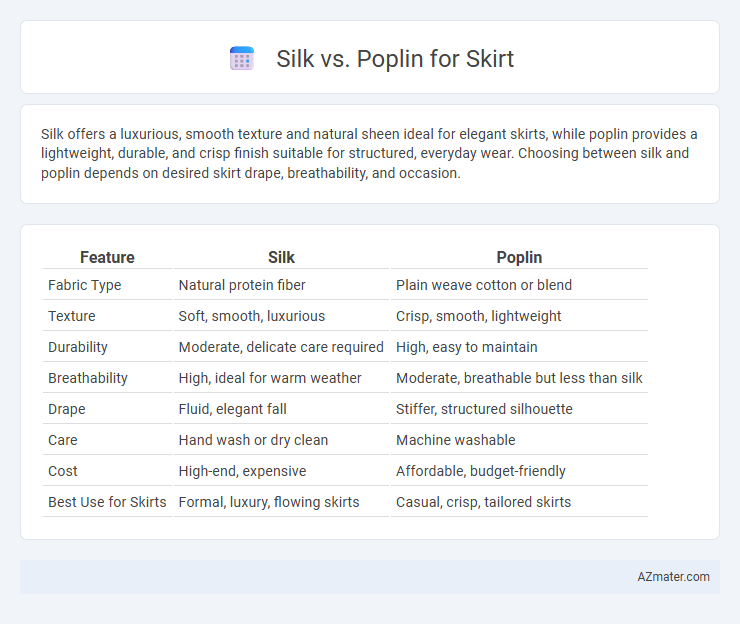Silk offers a luxurious, smooth texture and natural sheen ideal for elegant skirts, while poplin provides a lightweight, durable, and crisp finish suitable for structured, everyday wear. Choosing between silk and poplin depends on desired skirt drape, breathability, and occasion.
Table of Comparison
| Feature | Silk | Poplin |
|---|---|---|
| Fabric Type | Natural protein fiber | Plain weave cotton or blend |
| Texture | Soft, smooth, luxurious | Crisp, smooth, lightweight |
| Durability | Moderate, delicate care required | High, easy to maintain |
| Breathability | High, ideal for warm weather | Moderate, breathable but less than silk |
| Drape | Fluid, elegant fall | Stiffer, structured silhouette |
| Care | Hand wash or dry clean | Machine washable |
| Cost | High-end, expensive | Affordable, budget-friendly |
| Best Use for Skirts | Formal, luxury, flowing skirts | Casual, crisp, tailored skirts |
Introduction to Silk and Poplin Fabrics
Silk, a natural protein fiber from silkworms, is prized for its luxurious smooth texture, sheen, and breathability, making it ideal for elegant skirts. Poplin, traditionally a plain-weave cotton fabric with a crisp, lightweight feel, offers durability and a structured drape suitable for everyday wear. Choosing between silk and poplin for skirts depends on the desired balance of softness, sheen, breathability, and maintenance requirements.
Key Characteristics of Silk
Silk is a natural protein fiber known for its luxurious softness, smooth texture, and exceptional sheen, making it ideal for elegant skirts. It offers excellent breathability and moisture-wicking properties, providing comfort in both warm and cool climates. Silk's natural elasticity and strength contribute to durable yet flowing skirts that drape beautifully.
Key Characteristics of Poplin
Poplin fabric features a tightly woven plain weave that provides a smooth, crisp texture ideal for structured skirts. Its durability and lightweight nature make it resistant to wrinkles, maintaining a neat appearance throughout the day. Poplin's breathable cotton or cotton-blend fibers ensure comfort, especially in warm weather, distinguishing it from the delicate and slippery nature of silk.
Comfort and Wearability Comparison
Silk skirts offer unparalleled softness and natural breathability, making them extremely comfortable for all-day wear, while poplin skirts provide a crisp, lightweight feel with greater durability and wrinkle resistance. Poplin's cotton or cotton-blend composition allows for better moisture absorption and ease of movement, ideal for active or warmer environments. Silk excels in draping elegantly but requires delicate care, whereas poplin is more practical for everyday use due to its resilience and low maintenance.
Durability: Silk vs Poplin Skirts
Silk skirts offer a luxurious feel but tend to be less durable due to silk's delicate fibers, which are prone to snagging and wear over time. Poplin skirts, crafted from tightly woven cotton or cotton-blend fabric, provide higher resistance to tearing and maintain their shape better through frequent use and washing. For long-lasting skirts with sturdy fabric quality, poplin is generally the more durable choice compared to silk.
Breathability and Climate Suitability
Silk offers superior breathability due to its natural protein fiber structure, making it ideal for warm and humid climates by allowing moisture to evaporate quickly. Poplin, typically made from tightly woven cotton or a cotton-polyester blend, provides moderate breathability and better durability, suitable for transitional weather or cooler temperatures. Choosing silk enhances comfort in hot climates, while poplin delivers a more versatile option that balances breathability with structure.
Aesthetic Appeal and Texture Differences
Silk skirts offer a luxurious, smooth texture with a natural sheen that enhances the garment's elegance, making them ideal for formal occasions. Poplin skirts feature a crisp, tightly woven texture with a matte finish, providing a structured and clean look suitable for casual or office wear. The choice between silk and poplin hinges on whether a glossy, fluid drape or a more tailored, durable fabric aligns with the desired aesthetic appeal and tactile experience.
Care and Maintenance Requirements
Silk skirts require delicate care, including hand washing with mild detergent or dry cleaning to maintain fabric integrity and prevent damage from heat and water exposure. Poplin skirts are more durable, often machine washable at gentle cycles, making them easier to maintain with less risk of shrinking or color fading. Proper ironing techniques differ: silk demands low heat with a cloth barrier, while poplin tolerates medium heat, ensuring longevity and preserving the garment's appearance.
Price and Accessibility
Silk skirts typically come at a higher price point due to the costly production process and the luxurious nature of the fabric, making them less accessible for budget-conscious shoppers. Poplin skirts offer a more affordable alternative, with prices generally lower because of the fabric's cotton or polyester blend and simpler manufacturing. Poplin is widely available in numerous retail outlets and online stores, whereas high-quality silk skirts may require shopping at specialty boutiques or luxury brands.
Choosing the Best Fabric for Your Skirt
Silk offers a luxurious, smooth texture with natural sheen and excellent breathability, making it ideal for elegant skirts that drape beautifully. Poplin, a tightly woven cotton or cotton-blend fabric, provides durability, wrinkle resistance, and a crisp finish, perfect for casual and structured skirt designs. Choosing between silk and poplin depends on the desired look, comfort level, and occasion, with silk suited for formal wear and poplin excelling in everyday practicality.

Infographic: Silk vs Poplin for Skirt
 azmater.com
azmater.com